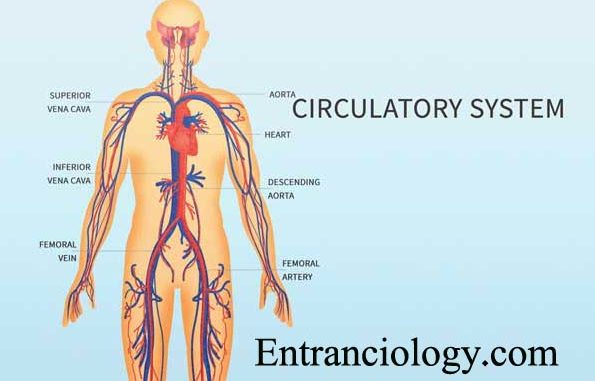
The Heart (Cardiovascular), Lungs (Pulmonary), and arteries, veins, coronary and portal vessels (Systemic) are the three independent systems in the human body. These systems work together and make Human Circulatory System that is responsible for the circulation and transportation of blood, nutrients, Oxygen and various others gases, hormones, blood cells to and from the cells in the body. The system provides nourishment, helps to fight diseases, and maintain various processes in the human body.
| Blood Volume | 6.8 Litres (in 70 kg body) | |
| Normal B.P. | 120/80 mm Hg | |
| Number of R.B.C. | In Male: 4.5-5.0 Million/Cubic MM | |
| In Female: 4.0-4.5 Million/Cubic MM | ||
| Life Span of R.B.C. | 120 days | |
| Normal W.B.C. Count | 5000-10000/Cubic MM | |
| Life Span of W.B.C. | 3-4 Days | |
| D.L.C. (Differential Leucocyte Count) | Basophils | 0.5-1% |
| Eosinophils | 1-3% | |
| Monocytes | 3-8% | |
| Neutrophils | 40-70% | |
| Lymphocytes | 2-25% | |
| Blood Platelets Count | 2,00,000-4,00,000/Cubic MM | |
| Haemoglobin | In Male | 14-15.6 gm/100 cc of blood |
| In Female | 11-14 gm/100 cc of blood | |
| Hb Content in Body | 500-700 gm | |
| Universal Blood Donor | O Rh –ve | |
| Universal Blood Recipient | AB | |
| Blood Clotting Time | 2-5 Minutes | |
| Normal Heart Beat (or Pulse Rate) | 72-75/Minutes | |
| Largest Artery | Abdominal Aorta | |
| Largest Vein | Inferior Venacava | |
| Largest W.B.C. | Monocyte | |
| Smallest W.B.C. | Lymphocyte | |
| ESR (Normal Erythrocyte sedimentation rate) | 4.10 min/hour | |
| pH of Blood | 7.35.7.45 | |
| pH of Semen | 7.5 | |


